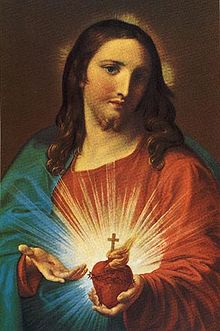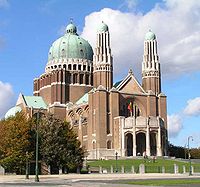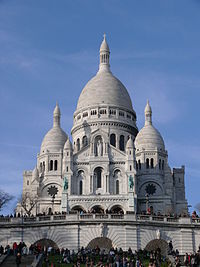- Sacred Heart
-
For other uses, see Sacred Heart (disambiguation).
The Sacred Heart (also known as Most Sacred Heart of Jesus) is one of the most famous religious devotions to Jesus' physical heart as the representation of His divine love for Humanity.
This devotion is predominantly used in the Catholic Church and among some high-church Anglicans and Lutherans. The devotion especially emphasizes the unmitigated love, compassion, and long-suffering of the heart of Christ towards humanity. The origin of this devotion in its modern form is derived from a French Roman Catholic nun, Marguerite Marie Alacoque, who said she learned the devotion from Jesus during a mystical experience. Predecessors to the modern devotion arose unmistakably in the Middle Ages in various facets of Catholic mysticism.[1]
In the Roman Catholic tradition, the Sacred Heart has been closely associated with Acts of Reparation to Jesus Christ. In his encyclical Miserentissimus Redemptor, Pope Pius XI stated: "the spirit of expiation or reparation has always had the first and foremost place in the worship given to the Most Sacred Heart of Jesus".[2] The Golden Arrow Prayer directly refers to the Sacred Heart.
Devotion to the Sacred Heart is sometimes seen in the Eastern Catholic Churches, where it remains a point of controversy and is seen as an example of Liturgical Latinisation.
The Sacred Heart is often depicted in Christian art as a flaming heart shining with divine light, pierced by the lance-wound, surrounded by the crown of thorns, surmounted by a cross and bleeding. Sometimes the image shown shining within the bosom of Christ with his wounded hands pointing at the heart. The wounds and crown of thorns allude to the manner of Jesus' death, while the fire represents the transformative power of divine love.
The Feast of the Sacred Heart has been in the Roman Catholic liturgical calendar since 1856, and is celebrated 19 days after Pentecost. As Pentecost is always celebrated on Sunday, the Feast of the Sacred Heart always falls on a Friday.
Part of a series of articles on
Roman Catholic
Devotions to Christ
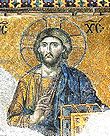
Devotions
Holy Face
Sacred Heart
Divine Mercy
Eucharistic adoration
Holy Name
Holy Hour
Acts of Reparation
Holy Wounds
Rosary of Holy Wounds
Stations of the Cross
Precious Blood
Infant of PraguePrayers to Jesus
Anima Christi • Shoulder Wound • Morning offering • Sacred Heart prayer • Sacred Heart Consecration • You are Christ • Vianney's prayer • Perboyre's prayer • Montfort's prayer • Crucifix prayerContents
History of Devotion
 Sacred Heart of Jesus by José María Ibarrarán y Ponce, 1896
Sacred Heart of Jesus by José María Ibarrarán y Ponce, 1896
Early devotion
From the time of John the Evangelist and Paul of Tarsus there has always been in the Church something like devotion to the love of God, but there is nothing to indicate that, during the first ten centuries of Christianity, any worship was rendered to the wounded Heart of Jesus.[3] It is in the eleventh and twelfth centuries that the first indications of devotion to the Sacred Heart are found. It was in the fervent atmosphere of the Benedictine or Cistercian monasteries, in the world of Anselmian or Bernardine thought, that the devotion arose, although it is impossible to say positively what were its first texts or who were its first devotees. It was already well known to St. Gertrude, St. Mechtilde, and the author of the Vitis mystica (previously ascribed to St. Bernard, now attributed to St. Bonaventure).
From the thirteenth to the sixteenth centuries, the devotion was propagated but it did not seem to have developed in itself. It was everywhere practised by individuals and by different religious congregations, such as the Franciscans, Dominicans, Carthusians, etc. It was, nevertheless, a private, individual devotion of the mystical order. Nothing of a general movement had been inaugurated, except for similarities found in the devotion to the Five Wounds by the Franciscans, in which the wound in Jesus's heart figured most prominently.
In the sixteenth century, the devotion passed from the domain of mysticism into that of Christian asceticism. It was established as a devotion with prayers already formulated and special exercises, found in the writings of Lanspergius (d. 1539) of the Carthusians of Cologne, the Louis of Blois (Blosius; 1566), a Benedictine and Abbot of Liessies in Hainaut, John of Avila (d. 1569) and St. Francis de Sales, the latter belonging to the seventeenth century.
The historical record from that time shows an early bringing to light of the devotion. Ascetic writers spoke of it, especially those of the Society of Jesus. The image of the Sacred Heart of Jesus was everywhere in evidence, largely due to the Franciscan devotion to the Five Wounds and to the habit formed by the Jesuits of placing the image on their title-page of their books and the walls of their churches.
Nevertheless, the devotion remained an individual, or at least a private, devotion. Jean Eudes (1602–1680) made it public, gave it an Office, and established a feast for it. Père Eudes was the apostle of the Heart of Mary; but in his devotion to the Immaculate Heart there was a share for the Heart of Jesus. Little by little, the devotion to the Sacred Heart became a separate one, and on August 31, 1670, the first feast of the Sacred Heart was celebrated in the Grand Seminary of Rennes. Coutances followed suit on October 20, a day with which the Eudist feast was from then on to be connected. The feast soon spread to other dioceses, and the devotion was likewise adopted in various religious communities. It gradually came into contact with the devotion begun at Paray, and resulting in a fusion of the two.
Visions of Saint Margaret Mary Alacoque
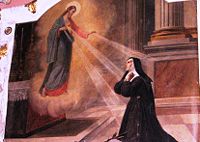 Painting representing the famous apparition of the Sacred Heart of Jesus to Saint Margaret Mary Alacoque.
Painting representing the famous apparition of the Sacred Heart of Jesus to Saint Margaret Mary Alacoque.
The most significant source for the devotion to the Sacred Heart in the form it is known today was Visitandine Saint Margaret Mary Alacoque (1647–1690), who claimed to have received visions of Jesus Christ. There is nothing to indicate that she had known the devotion prior to the revelations, or at least that she had paid any attention to it. The revelations were numerous, and the following apparitions are especially remarkable:
- On December 27, probably 1673, the feast of St. John, Margaret Mary reported that Jesus permitted her, as He had formerly allowed St. Gertrude, to rest her head upon His Heart, and then disclosed to her the wonders of His love, telling her that He desired to make them known to all mankind and to diffuse the treasures of His goodness, and that He had chosen her for this work.
- In probably June or July, 1674, Margaret Mary claimed that Jesus requested to be honored under the figure of His Heart of flesh, also claiming that, when He appeared radiant with love, He asked for a devotion of expiatory love: frequent reception of Communion, especially Communion on the First Friday of the month, and the observance of the Holy Hour.
- During the octave of Corpus Christi, 1675, probably on June 16, the vision known as the "great apparition" reportedly took place, where Jesus said, "Behold the Heart that has so loved men ... instead of gratitude I receive from the greater part (of mankind) only ingratitude ...", and asked Margaret Mary for a feast of reparation of the Friday after the octave of Corpus Christi, bidding her consult her confessor Father Claude de la Colombière, then superior of the small Jesuit house at Paray. Solemn homage was asked on the part of the king, and the mission of propagating the new devotion was especially confided to the religious of the Visitation and to the priests of the Society of Jesus.
A few days after the "great apparition", Margaret Mary reported everything she saw to Father de la Colombière, and he, acknowledging the vision as an action of the Spirit of God, consecrated himself to the Sacred Heart and directed her to write an account of the apparition. He also made use of every available opportunity to circulate this account, discreetly, through France and England. Upon his death on February 15, 1682, there was found in his journal of spiritual retreats a copy in his own handwriting of the account that he had requested of Margaret Mary, together with a few reflections on the usefulness of the devotion. This journal, including the account and an "offering" to the Sacred Heart, in which the devotion was well explained, was published at Lyons in 1684. The little book was widely read, especially at Paray. Margaret Mary reported feeling "dreadful confusion" over the book's contents, but resolved to make the best of it, approving of the book for the spreading of her cherished devotion. Outside of the Visitandines, priests, religious, and laymen espoused the devotion, particularly the Capuchins, Margaret Mary's two brothers, and some Jesuits. The Jesuit Father Croiset wrote a book called The Devotion to the Sacred Heart of Jesus, a book which Jesus is said to told Margaret to tell Fr. Croiset to write, and Fr. Joseph de Gallifet, also a Jesuit, promoted the devotion.
Papal Approvals
 The Blessed Mary of the Divine Heart was a nun from Sisters of the Good Shepherd Congregation who requested, in the name of Christ Himself, to Pope Leo XIII that he consecrate the entire World to the Sacred Heart of Jesus.[4]
The Blessed Mary of the Divine Heart was a nun from Sisters of the Good Shepherd Congregation who requested, in the name of Christ Himself, to Pope Leo XIII that he consecrate the entire World to the Sacred Heart of Jesus.[4]
The death of Margaret Mary Alacoque on October 17, 1690, did not dampen the zeal of those interested; on the contrary, a short account of her life published by Father Croiset in 1691, as an appendix to his book "De la Dévotion au Sacré Cœur", served only to increase it. In spite of all sorts of obstacles, and of the slowness of the Holy See, which in 1693 imparted indulgences to the Confraternities of the Sacred Heart and, in 1697, granted the feast to the Visitandines with the Mass of the Five Wounds, but refused a feast common to all, with special Mass and Office. The devotion spread, particularly in religious communities. The Marseilles plague, 1720, furnished perhaps the first occasion for a solemn consecration and public worship outside of religious communities. Other cities of the South followed the example of Marseilles, and thus the devotion became a popular one. In 1726 it was deemed advisable once more to importune Rome for a feast with a Mass and Office of its own, but, in 1729, Rome again refused. However, in 1765, it finally yielded and that same year, at the request of the queen, the feast was received quasi-officially by the episcopate of France. On all sides it was asked for and obtained, and finally, in 1856, at the urgent entreaties of the French bishops, Pope Pius IX extended the feast to the Roman Catholic Church under the rite of double major. In 1889 it was raised by the Roman Catholic Church to the double rite of first class.
After the letters of Mother Mary of the Divine Heart (1863–1899) requesting, in the name of Christ Himself, to Pope Leo XIII consecrate the entire World to the Sacred Heart of Jesus, the Holy Father commissions a group of theologians to examine the petition on the basis of revelation and sacred tradition. This investigation was positive. And so in the encyclical letter Annum Sacrum (on May 25, 1899) this same pope decreed that the consecration of the entire human race to the Sacred Heart of Jesus should take place on June 11, 1899. In this encyclical letter the Pope attached Later Pope Leo XIII encouraged the entire Roman Catholic episcopate to promote the devotion of the Nine First Fridays and he established June as the Month of the Sacred Heart. Leo XIII also composed the Prayer of Consecration to the Sacred Heart and included it in Annum Sacrum.[5]
Pope Pius X decreed that the consecration of the human race, performed by Pope Leo XIII be renewed each year. Pope Pius XI in his encyclical letter Miserentissimus Redemptor (on May 8, 1928) affirmed the Church's position with respect to Saint Margaret Mary's visions of Jesus Christ by stating that Jesus had "manifested Himself" to Saint Margaret and had "promised her that all those who rendered this honor to His Heart would be endowed with an abundance of heavenly graces." The encyclical refers to the conversation between Jesus and Saint Margaret several times[2] and reaffirmed the importance of consecration and reparation to the Sacred Heart of Jesus.
Finally, Venerable Pope Pius XII, on the occasion of the 100th anniversary of Pope Pius IX's institution of the Feast, instructed the entire Roman Catholic Church at length on the devotion to the Sacred Heart in his encyclical letter Haurietis aquas (on May 15, 1956). On May 15, 2006, also Pope Benedict XVI sent a letter to Father Peter Hans Kolvenbach, the Superior General of the Society of Jesus, on the 50th Anniversary of the encyclical Haurietis Aquas, about the Sacred Heart, by Pope Pius XII. In his letter to Father Kolvenbach, Pope Benedict XVI reaffirmed the importance of the devotion to the Sacred Heart of Jesus.
Worship and Devotion
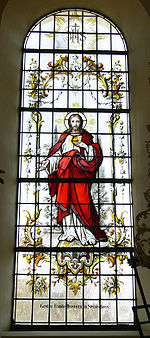 Stained glass depiction of Jesus and His Most Sacred Heart, in Germany.
Stained glass depiction of Jesus and His Most Sacred Heart, in Germany.
The Roman Catholic acts of consecration, reparation and devotion were introduced when the feast of the Sacred Heart was declared. In his Papal Bull Auctorem Fidei, Pope Pius VI praised devotion to the Sacred Heart. Finally, by order of Leo XIII, in his encyclical Annum Sacrum (May 25, 1899), as well as on June 11, he consecrated every human to the Sacred Heart. The idea of this act, which Leo XIII called "the great act" of his pontificate, had been proposed to him by a religious woman of the Good Shepherd from Oporto (Portugal) who said that she had supernaturally received it from Jesus. Since c. 1850, groups, congregations, and States have consecrated themselves to the Sacred Heart. In 1873, by petition of president Gabriel García Moreno, Ecuador was the first country in the world to be consecrated to the Sacred Heart, fulfilling God's petition to Saint Margaret Mary over two hundred years later.
 The Titular Statue of the Sacred Heart on Feast Day in Fontana, Gozo in Malta. All families in Gozo were consecrated to the Sacred Heart in the year 2000, on the initiative of Fontana's Parish.
The Titular Statue of the Sacred Heart on Feast Day in Fontana, Gozo in Malta. All families in Gozo were consecrated to the Sacred Heart in the year 2000, on the initiative of Fontana's Parish.
Peter Coudrin of France founded the Congregation of the Sacred Hearts of Jesus and Mary on December 24, 1800. A religious order of the Roman Catholic Church, the order is best known for its missionary work in Hawaii.
Mother Clelia Merloni from Forlì (Italy) founded the Congregation of the Apostles of the Sacred Heart of Jesus in Viareggio, Italy, May 30, 1894.
Worship of the Sacred Heart mainly consists of several hymns, the Salutation of the Sacred Heart, and the Litany of the Sacred Heart. It is common in Roman Catholic services and occasionally is to be found in Anglican services.
The Feast of the Sacred Heart is a solemnity in the Roman Catholic liturgical calendar, and is celebrated 19 days after Pentecost. As Pentecost is always celebrated on Sunday, the Feast of the Sacred Heart always falls on a Friday.
The Enthronement of the Sacred Heart is a Roman Catholic ceremony in which a priest or head of a household consecrates the members of the household to the Sacred Heart. A blessed image of the Sacred Heart, either a statue or a picture, is then "enthroned" in the home to serve as a constant reminder to those who dwell in the house of their consecration to the Sacred Heart. The practice of the Enthronement is based upon Pope Pius XII's declaration that devotion to the Sacred of Jesus is "the foundation on which to build the kingdom of God in the hearts of individuals, families, and nations..."[6]
Alliance with the Immaculate Heart
 Henriette Aymer de Chevalerie co-founded the Congregation of the Sacred Hearts of Jesus and Mary with Peter Coudrin in 1800.
Henriette Aymer de Chevalerie co-founded the Congregation of the Sacred Hearts of Jesus and Mary with Peter Coudrin in 1800. Main article: Alliance of the Hearts of Jesus and Mary
Main article: Alliance of the Hearts of Jesus and MaryThe Alliance of the Hearts of Jesus and Mary is based on the historical, theological and spiritual links in Catholic devotions to the Sacred Heart of Jesus and the Immaculate Heart of Mary.[7][8][9] The joint devotion to the hearts was first formalized in the 17th century by Saint Jean Eudes who organized the scriptural, theological and liturgical sources relating to the devotions and obtained the approbation of the Church, prior to the visions of Saint Marguerite Marie Alacoque.[10][11][12]
In the 18th and 19th centuries the devotions grew, both jointly and individually through the efforts of figures such as Saint Louis de Montfort who promoted Catholic Mariology and Saint Catherine Labouré's Miraculous Medal depicting the Heart of Jesus thorn-crowned and the Heart of Mary pierced with a sword.[13][14][15] The devotions, and the associated prayers, continued into the 20th century, e.g. in the Immaculata prayer of Saint Maximillian Kolbe and in the reported messages of Our Lady of Fatima which stated that the Heart of Jesus wishes to be honored together with the Heart of Mary.[16][17]
Popes supported the individual and joint devotions to the hearts through the centuries. In the 1956 encyclical Haurietis Aquas, Pope Pius XII encouraged the joint devotion to the hearts. In the 1979 encyclical Redemptor Hominis Pope John Paul II explained the theme of unity of Mary's Immaculate Heart with the Sacred Heart.[18] In his Angelus address on September 15, 1985 Pope John Paul II coined the term The Alliance of the Hearts of Jesus and Mary, and in 1986 addressed the international conference on that topic held at Fátima, Portugal.[19][20][21][22]
Institution Names
Sacred Heart is still a widely used name for many Roman Catholic institutions, including schools, colleges, and hospitals in many countries around the world. It is also the name of many Roman Catholic parishes, religious orders, and stores selling Roman Catholic goods.
For a list of institutions named after the Sacred Heart, see Sacred Heart (disambiguation).
Sacred Heart imagery
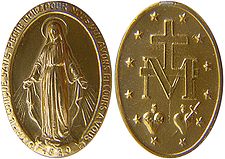 The Sacred Heart crowned with thorns, appearing on the Miraculous Medal.
The Sacred Heart crowned with thorns, appearing on the Miraculous Medal.
The Sacred Heart has also been involved in (and been depicted) in saintly apparitions such as those to Saint Catherine Labouré in 1830 and appears on the Miraculous Medal.[23] On the Miraculous Medal, the Sacred Heart is crowned with thorns. The Immaculate Heart of Mary also appears on the medal, next to the Sacred Heart, but is pierced by a sword, rather than being crowned with thorns. The M on the medal signifies the Blessed Virgin at the foot of the Cross when Jesus was being crucified.
Religious imagery depicting the Sacred Heart is frequently featured in Roman Catholic, and sometimes Anglican and Lutheran homes. Sometimes images display beneath them a list of family members, indicating that the entire family is entrusted to the protection of Jesus in the Sacred Heart, from whom blessings on the home and the family members are sought. The prayer "O Sacred Heart of Jesus, I place all my trust in Thee" is often used. One particular image has been used as part of a set, along with an image of the Blessed Virgin Mary. In that image, Mary too was shown pointing to her Immaculate Heart, expressing her love for the human race and for her Son, Jesus Christ. The mirror images reflect an eternal binding of the two hearts.
The Scapular of the Sacred Heart and the Scapular of the Sacred Hearts of Jesus and Mary are worn by Roman Catholics.[24][25]
In Eastern Catholicism
Devotion to the Sacred Heart may be found in some Eastern Catholic Churches, but is a contentious issue. Those who favour purity of rite are opposed to the devotion, while those who are in favour of the devotion cite it as a point of commonality with their Latin Catholic brethren.
Promises of the Sacred Heart
Jesus Christ, in his appearances to Saint Margaret Mary Alacoque, allegedly promised these blessings to those who practice devotion to his Sacred Heart. This tabular form of promises was not made by Saint Margaret Mary or her contemporaries. It first appeared at 1863. In 1882, an American businessman spread the tabular form of the promises profusely throughout the world, the twelve promises appearing in 238 languages. In 1890, Cardinal Adolph Perraud deplored this circulation of the promises in the tabular form which were different from the words and even from the meaning of the expressions used by St. Margaret Mary, and wanted the promises to be published in the full, authentic texts as found in the writings of St. Margaret Mary.[26]
- I will give them all the graces necessary for their state of life.
- I will give peace in their families.
- I will console them in all their troubles.
- I will be their refuge in life and especially in death.
- I will abundantly bless all their undertakings.
- Sinners shall find in my Heart the source and infinite ocean of mercy.
- Tepid souls shall become fervent.
- Fervent souls shall rise speedily to great perfection.
- I will bless those places wherein the image of My Sacred Heart shall be exposed and venerated.
- I will give to priests the power to touch the most hardened hearts.
- Persons who propagate this devotion shall have their names eternally written in my Heart.
- In the excess of the mercy of my Heart, I promise you that my all powerful love will grant to all those who will receive Communion on the First Fridays, for nine consecutive months, the grace of final repentance: they will not die in my displeasure, nor without receiving the sacraments; and my Heart will be their secure refuge in that last hour.
The last promise has given rise to the pious Roman Catholic practice of making an effort to attend Mass and receive Communion on the first Friday of each month.
Great efficacy of converting people has been attached to the use of the image of the Sacred Heart.
"Even at the hour of death, incredulous, indifferent, hardened souls have been converted by simply showing them a picture of the Sacred Heart, which sufficed to restore these sinners to the life of hope and love, in a word, to touch the most hardened. It would, indeed, be a great misfortune to any apostolic man to neglect so powerful a means of conversion, and in proof of this I will mention a single fact which will need no comment. A religious of the Company of Jesus had been requested by the Blessed Margaret Mary to make a careful engraving of the Sacred Heart. Being often hindered by other occupations, there was much delay in preparing this plate. ' This good father,' writes the saint, 'is so much occupied by Mon- signor d'Autun in the conversion of heretics, that he has neither time nor leisure to give to the work so ardently desired by the Heart of our Divine Master. You cannot imagine, my much-loved mother, how greatly this delay afflicts and pains me. I must avow confidently to you my belief that it is the cause of his converting so few infidels in this town. I seem constantly to hear these words : ' That if this good father had acquitted himself at once of his promise to the Sacred Heart, Jesus would have changed and converted the hearts of these infidels, on account of the joy He would have felt at seeing Himself honoured in the picture He so much wishes for. As, however, he prefers other work, even though to the glory of God, to that of giving Him this satisfaction, He will harden the hearts of these infidels, and the labours of this mission will not be crowned with much fruit.' [3]
Scapular of the Sacred Heart
A series of articles on the Sacred Heart of Jesus

Sacred Heart
Immaculate Heart
Alliance of HeartsPrayers & Feast
Act of Consecration
Prayer • Feast
ScapularPeople
John Eudes
Margaret Alacoque
Catherine Labouré
Mary of Divine Heart
Alexandrina da CostaEncyclicals
Annum Sacrum
Haurietis AquasChurches
Cathedrals • ChurchesThe devotions to the Sacred Heart of Jesus also involve the Scapular of the Sacred Heart. It is a Roman Catholic devotional scapular that can be traced back to Saint Margaret Marie Alacoque who herself made and distributed badges similar to it.[27] In 1872 Pope Pius IX granted an indulgence for the badge and the actual scapular was approved by the Congregation of Rites in 1900. It bears the representation of the Sacred Heart of Jesus on one side, and that of the Blessed Virgin Mary under the title of Mother of Mercy on the other side.
Litany of the Sacred Heart of Jesus
Dates for the Feast of the Sacred Heart, 2009-2020 Year Date 2009 June 19 2010 June 11 2011 July 1 2012 June 15 2013 June 7 2014 June 27 2015 June 12 2016 June 3 2017 June 23 2018 June 8 2019 June 28 2020 June 19 V. Lord, have mercy on us.
R. Christ, have mercy on us.
V. Lord, have mercy on us. Christ, hear us.
R. Christ, graciously hear us.
V. God the Father of Heaven, have mercy on us.
God the Son, Redeemer of the world, have mercy on us.
God the Holy Ghost, have mercy on us.
Holy Trinity, one God, have mercy on us.
Heart of Jesus, Son of the Eternal Father, have mercy on us.
Heart of Jesus, formed in the womb of the Virgin Mother by the Holy Ghost, have mercy on us.
Heart of Jesus, united substantially to the Word of God.
Heart of Jesus, of infinite majesty.
Heart of Jesus, holy temple of God.
Heart of Jesus, tabernacle of the Most High.
Heart of Jesus, house of God and gate of heaven.
Heart of Jesus, glowing furnace of charity.
Heart of Jesus, vessel of justice and love.
Heart of Jesus, full of goodness and love.
Heart of Jesus, abyss of all virtues.
Heart of Jesus, most worthy of all praise.
Heart of Jesus, King and center of all hearts.
Heart of Jesus, in whom art all the treasures of wisdom and knowledge.
Heart of Jesus, in whom dwelleth all the fullness of the Godhead.
Heart of Jesus, in whom the Father was well pleased.
Heart of Jesus, of whose fullness we have all received.
Heart of Jesus, desire of the everlasting hills.
Heart of Jesus, patient and rich in mercy.
Heart of Jesus, rich to all who call upon Thee.
Heart of Jesus, fount of life and holiness.
Heart of Jesus, propitiation for our offenses.
Heart of Jesus, overwhelmed with reproaches.
Heart of Jesus, bruised for our iniquities.
Heart of Jesus, obedient even unto death.
Heart of Jesus, pierced with a lance.
Heart of Jesus, source of all consolation.
Heart of Jesus, our life and resurrection.
Heart of Jesus, our peace and reconciliation.
Heart of Jesus, victim for our sins.
Heart of Jesus, salvation of those who hope in Thee.
Heart of Jesus, hope of those who die in Thee.
Heart of Jesus, delight of all saints.
V. Lamb of God, who takest away the sins of the world,
R. spare us, O Lord.
V. Lamb of God, who takest away the sins of the world,
R. graciously hear us, O Lord.
V. Lamb of God, who takest away the sins of the world,
R. have mercy on us.
V. Jesus, meek and humble of Heart,
R. Make our hearts like unto Thine.
Let us pray.
Almighty and everlasting God, look upon the Heart of Thy well-beloved Son and upon the acts of praise and satisfaction which He renders unto Thee in the name of sinners; and do Thou, in Thy great goodness, grant pardon to them who seek Thy mercy, in the name of the same Thy Son, Jesus Christ, who liveth and reigneth with Thee, world without end.See also
- Annum Sacrum
- Act of Consecration to the Sacred Heart of Jesus
- Catholic devotions
- Immaculate Heart of Mary
- Alliance of the Hearts of Jesus and Mary
- Sacred Heart Cathedral
- Cathedral of the Sacred Heart
Notes
- ^ "Devotion to the Sacred Heart of Jesus II. Historical Ideas on the Development of the Devotion, para (3-4)". Catholic Encyclopedia. New Advent. http://www.newadvent.org/cathen/07163a.htm. Retrieved 11 July 2006.
- ^ a b Miserentissimus Redemptor Encyclical of Pope Pius XI http://www.vatican.va/holy_father/pius_xi/encyclicals/documents/hf_p-xi_enc_08051928_miserentissimus-redemptor_en.html
- ^ "Devotion to the Sacred Heart of Jesus II. Historical Ideas on the Development of the Devotion, para (1)". Catholic Encyclopedia. New Advent. http://www.newadvent.org/cathen/07163a.htm. Retrieved 11 July 2006.
- ^ CHASLE, Louis; Sister Mary of the Divine Heart, Droste zu Vischering, religious of the Good Shepherd, 1863-1899. Burns & Oates, London, 1906.
- ^ Ann Ball, 2003 Encyclopedia of Catholic Devotions and Practices ISBN 0-87973-910-X page 166
- ^ Pope Pius XII. "Haurietis Aquas". Vatican Archives. http://www.vatican.va/holy_father/pius_xii/encyclicals/documents/hf_p-xii_enc_15051956_haurietis-aquas_en.html. Retrieved November 17, 2006.
- ^ Mary's Immaculate Heart by John F. Murphy 2007 ISBN 1406734098 pages 59-60
- ^ Heart of the Redeemer by Timothy Terrance O'Donnell, 1992 ISBN 0898703964 page 272
- ^ Arthur Calkins, The Theology of the Alliance of the Two Hearts, Missio Immaculatae (English Edition) Year III, N° 4 (May to December 2007). [1]
- ^ Roman Catholic worship: Trent to today by James F. White 2003 ISBN 0814661947 page 34
- ^ From Trent to Vatican II: historical and theological investigations by Raymond F. Bulman, Frederick J. Parrella 2006 ISBN 0195178076 page 182
- ^ Praying with the saints by Woodeene Koenig-Bricker 2001 ISBN 0829417559 page 134
- ^ In Prayer With Mary the Mother of Jesus by Jean Lafrance 1988 ISBN 2890391833 page 310
- ^ Companion to the Calendar: A Guide to the Saints and Mysteries by Mary Ellen Hynes 2007 ISBN 1568540116 page 24
- ^ Butler's lives of the saints, Volume 12 by Alban Butler, Kathleen Jones, 2000 ISBN 0860122611 page 245
- ^ Youngest Prophet by Christopher Rengers 1998 ISBN 0853428158 page 38
- ^ The children of Fatima: Blessed Francisco & Blessed Jacinta Marto by Leo Madigan 2003 OSV Press ISBN 1931709572 page 248
- ^ Peter Stravinskas, 2002, Catholic Dictionary, OSV Press ISBN 9780879733902 page 485
- ^ Pope John Paul II 1986 Speech at the Vatican Website
- ^ Arthur Calkins, The Alliance of the Two Hearts and Consecration, Miles Immaculatae XXXI (July/December 1995) 389-407. [2]
- ^ Proceedings of the International Theological Symposium on the Alliance of the Hearts of Jesus and Mary, September 1986, Fátima, Portugal
- ^ Vatican website: Pope John Paul II Angelus address of September 15, 1985 (Spanish and Italian)
- ^ Catholic encyclopedia
- ^ Catholic encyclopedia
- ^ Ann Ball, 2003, Encyclopedia of Catholic Devotions and Practices ISBN 087973910X page 517
- ^ The Fr. Paul Wenisch. Promises of Our Lord to Saint Margaret (1920) pg. 3 http://search.msn.com/books#q=devotion%20sacred%20heart%20croiset&filter=all&page=1&t=WAHoaQiCLurFchPo5Nkzgg&sq=devotion%20sacred%20heart%20croiset
- ^ Catholic Encyclopedia
References
 This article incorporates text from a publication now in the public domain: Herbermann, Charles, ed (1913). Catholic Encyclopedia. Robert Appleton Company.
This article incorporates text from a publication now in the public domain: Herbermann, Charles, ed (1913). Catholic Encyclopedia. Robert Appleton Company.External links
- Devotion to the Sacred Heart of Jesus, which was commanded to be written by Jesus Himself through St. Margaret Mary
- Devotion to the Sacred Heart of Jesus, from Catholic Encyclopedia.
- Catholic Devotion to the Sacred Heart of Jesus.
- What is consecration and commitment to the hearts of Jesus and Mary.
- http://sacredheart.vndv.com/sacred2.htm The Life of Saint Margaret Mary in her own words].
- Sister Servants of the Most Sacred Heart of Jesus.
- St. Therese of Lisieux and the Sacred Heart of Jesus.
- The Apostleship of Prayer and the Sacred Heart of Jesus.
Categories:- Sacramentals
- Jesus
- Catholic theology and doctrine
- Roman Catholic Church art by subject
- Christian symbols
- Catholic holy days
- Roman Catholic devotions
- Iconography of Jesus
Wikimedia Foundation. 2010.

